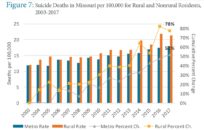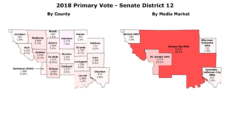Bollinger County is a small but vibrant community of hardworking families, business owners, farmers, and students. It’s a nearly ideal place to work, live, and raise a family, and over the past few years we’ve seen an increase in businesses, homeowners, and others looking to join our community. But whether it’s lifelong residents or newcomers, we continue to hear that Bollinger County is missing one critical resource: adequate broadband internet access.
While many Missouri communities are making progress in closing the digital divide, others remain far behind. Our county has the lowest broadband coverage of any of the state’s 114 counties. To identify solutions to this problem, we formed the Bollinger County Broadband Task Force. This work started prior to the pandemic, but COVID-19 made it more urgent than ever. For too many people, online education, telehealth, and working from home were simply not possible. Now, even as normal life is getting back into full swing, a reliable high-speed internet connection is critical.
Fortunately, Bollinger County is one of many communities slated for significant broadband investments under the Federal Communications Commission’s Rural Digital Opportunity Fund (RDOF). Two providers will reach a significant portion of the county over the next few years, and we’re working with them to determine a path to reach 100 percent coverage. We’re also encouraged by Gov. Mike Parson’s announcement of plans to invest $400 million in broadband expansion — funding that Bollinger County will aggressively pursue with a qualified private-sector broadband provider.
However, funding is only half the battle. Many projects face multi-year timelines and substantial risks of delay if certain barriers remain unaddressed. This includes those supported by RDOF, the National Telecommunications and Information Association (NTIA), and other sources.
The most impactful way to expedite these projects is by quickly upgrading or replacing aging utility poles, which serve as the backbone of our state’s broadband infrastructure. In rural areas like Bollinger County, where homes and businesses are spread far apart, broadband providers must often attach to multiple utility poles to serve just one home. When providers begin this work, they frequently find that old poles cannot support new broadband infrastructure and must be replaced — a process that becomes costly and time-consuming. If we’re going to get reliable high-speed internet to our residents sooner rather than later, our utility pole infrastructure must be modernized.
A dedicated fund to upgrade this infrastructure would be a tangible, effective investment, and it should be a core piece of the state’s broadband strategy this year. This includes ensuring that all current and future buildout projects, including those run through RDOF and the NTIA, are eligible for pole replacement funds.
The mission for Bollinger County and many other Missouri communities is clear: Deliver broadband access to unserved homes and businesses and do it quickly. Recent estimates suggest that breaking down pole-related barriers to universal broadband could unlock up to $8 billion in economic gains for the state.
Missouri currently ranks No. 32 in broadband availability, and we must turn the tide quickly. If the governor and the General Assembly prioritize this matter now, it will ensure a more connected future in which no Missourian lives on the wrong side of the digital divide.

Becky Wiginton is a member of the Bollinger County Broadband Task Force and the president of the Bollinger County Chamber of Commerce.

















